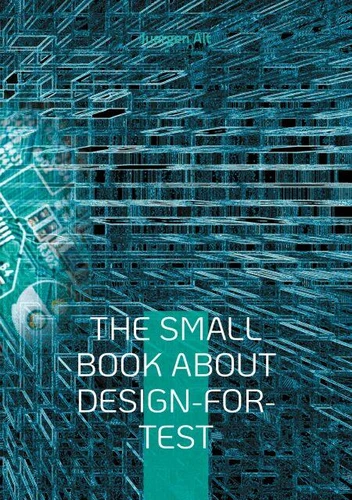The Small Book About Design-for-Test. A comprehensive guide to Design-for-Test methods in the semiconductor industry
Par :Formats :
Disponible dans votre compte client Decitre ou Furet du Nord dès validation de votre commande. Le format ePub est :
- Compatible avec une lecture sur My Vivlio (smartphone, tablette, ordinateur)
- Compatible avec une lecture sur liseuses Vivlio
- Pour les liseuses autres que Vivlio, vous devez utiliser le logiciel Adobe Digital Edition. Non compatible avec la lecture sur les liseuses Kindle, Remarkable et Sony
 , qui est-ce ?
, qui est-ce ?Notre partenaire de plateforme de lecture numérique où vous retrouverez l'ensemble de vos ebooks gratuitement
Pour en savoir plus sur nos ebooks, consultez notre aide en ligne ici
- Nombre de pages154
- FormatePub
- ISBN978-3-8192-3673-0
- EAN9783819236730
- Date de parution30/05/2025
- Protection num.Digital Watermarking
- Taille9 Mo
- Infos supplémentairesepub
- ÉditeurBoD - Books on Demand
Résumé
This book is designed for individuals working in the semiconductor industry who need a fundamental understanding of Design-for-Test (DfT) methods. It caters to test and product engineers who typically utilize these methods, as well as chip designers, project managers, and business owners who seek to comprehend the value of implemented DfT methods. Additionally, it serves as a starting point for beginners in DfT before delving deeper into implementation tools and test pattern generation tasks.
Originating from a university lecture, the core content of this book has expanded over the years.
It bridges the gap between theoretical textbook descriptions of DfT and its practical application in the industry. The goal is to present DfT as a collection of methods that maintain manufacturing test costs at a level that allows for reasonable selling prices, even for complex products utilizing the latest silicon technologies. The book is structured into three parts: - The first part provides a summary of DfT techniques and an introduction to pattern generation techniques. - The second part delves into established DfT techniques for special analogmixed signal circuits and memories within the industry. - The third part proposes a systematic approach to test concept engineering, maximizing the benefits of DfT methodologies. By exploring the fundamentals and advanced concepts of DfT, this book aims to equip readers with the knowledge and tools necessary to contribute to the ongoing innovation in semiconductor testing and development.
It bridges the gap between theoretical textbook descriptions of DfT and its practical application in the industry. The goal is to present DfT as a collection of methods that maintain manufacturing test costs at a level that allows for reasonable selling prices, even for complex products utilizing the latest silicon technologies. The book is structured into three parts: - The first part provides a summary of DfT techniques and an introduction to pattern generation techniques. - The second part delves into established DfT techniques for special analogmixed signal circuits and memories within the industry. - The third part proposes a systematic approach to test concept engineering, maximizing the benefits of DfT methodologies. By exploring the fundamentals and advanced concepts of DfT, this book aims to equip readers with the knowledge and tools necessary to contribute to the ongoing innovation in semiconductor testing and development.
This book is designed for individuals working in the semiconductor industry who need a fundamental understanding of Design-for-Test (DfT) methods. It caters to test and product engineers who typically utilize these methods, as well as chip designers, project managers, and business owners who seek to comprehend the value of implemented DfT methods. Additionally, it serves as a starting point for beginners in DfT before delving deeper into implementation tools and test pattern generation tasks.
Originating from a university lecture, the core content of this book has expanded over the years.
It bridges the gap between theoretical textbook descriptions of DfT and its practical application in the industry. The goal is to present DfT as a collection of methods that maintain manufacturing test costs at a level that allows for reasonable selling prices, even for complex products utilizing the latest silicon technologies. The book is structured into three parts: - The first part provides a summary of DfT techniques and an introduction to pattern generation techniques. - The second part delves into established DfT techniques for special analogmixed signal circuits and memories within the industry. - The third part proposes a systematic approach to test concept engineering, maximizing the benefits of DfT methodologies. By exploring the fundamentals and advanced concepts of DfT, this book aims to equip readers with the knowledge and tools necessary to contribute to the ongoing innovation in semiconductor testing and development.
It bridges the gap between theoretical textbook descriptions of DfT and its practical application in the industry. The goal is to present DfT as a collection of methods that maintain manufacturing test costs at a level that allows for reasonable selling prices, even for complex products utilizing the latest silicon technologies. The book is structured into three parts: - The first part provides a summary of DfT techniques and an introduction to pattern generation techniques. - The second part delves into established DfT techniques for special analogmixed signal circuits and memories within the industry. - The third part proposes a systematic approach to test concept engineering, maximizing the benefits of DfT methodologies. By exploring the fundamentals and advanced concepts of DfT, this book aims to equip readers with the knowledge and tools necessary to contribute to the ongoing innovation in semiconductor testing and development.



